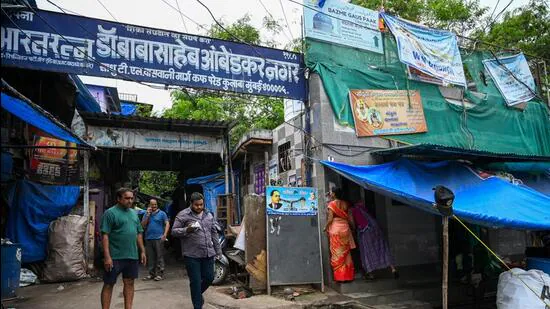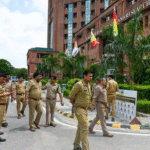Crores on Paper — Inside Mumbai’s Fake Development in Cuffe Parade’s Forgotten Slum
The Mirage of Development
In the labyrinthine lanes of Ambedkar Nagar, nestled behind the glitzy sea-facing skyline of South Mumbai’s Cuffe Parade, hundreds of families live cheek-by-jowl in 10×10 tin-roofed rooms. There are no permanent roads. Electricity cuts are frequent. Children study by candlelight when the monsoon knocks out power. Drainage overflows into living rooms. And yet — as per official records — this slum has seen development projects worth crores of rupees.
Only, they never happened.
In a revelation that has shocked Mumbai’s civic conscience, a recent municipal audit has exposed a series of fake development projects fraudulently shown as completed by the Brihanmumbai Municipal Corporation (BMC) in Ambedkar Nagar. The works existed on paper. The funds were released. Contractors were paid. But residents say they never saw a single labourer, brick, or machine.
This is not just a case of bureaucratic negligence. It is a systemic fraud, a collusion between civic officials and contractors to siphon public money using the poor as a front. And the scale — both in rupees and rot — is staggering.
Mumbai’s Richest Civic Body, Its Poorest Lies
The BMC, with a budget larger than some Indian states, is not short of funds. In 2024-25, its budget stood at over ₹59,000 crore. But in a city where inequality is both visible and violent, large sums set aside for slum infrastructure often vanish in vague descriptions — “footpath improvement,” “toilet repairs,” “stormwater drain clearance” — and are rarely audited on-ground.
This time, however, the fraud was caught by accident.
A routine internal audit conducted by BMC’s vigilance department in Ward A — which includes Cuffe Parade — stumbled upon duplicate entries, inflated bills, and photoshopped completion pictures. Further physical verification confirmed the worst: at least ₹4.88 crore was shown as spent on projects that never existed.
Some examples:
- A ₹68 lakh stormwater drain that residents say was “never seen, never built.”
- Repairs for public toilets that remain broken and unusable.
- Paved walkways listed in documents that, on ground, are just pools of stagnant water.
Shockingly, some projects were billed multiple times under different names — a classic method of laundering public works money.
Voices From the Ground: “Where Is This Work?”
When journalists visited Ambedkar Nagar, the reaction of residents was not rage — it was resignation.
“This happens every year. They say the lane is repaired, but we still jump over potholes,” said 53-year-old Shanta Jadhav, who has lived here for over two decades.
Pointing at a muddy trench, Abdul Rehman, a vegetable vendor, added:
“They put up a signboard saying ‘work in progress’ for three days last year. No one came. Then the board vanished.”
Many had no idea that crores had supposedly been spent on their locality. For them, it was just another year of empty promises — except this time, there’s evidence of loot.
The Audit Trail: How It Was Uncovered
The audit team, working on a random sampling method, noticed something odd: multiple work orders with identical scope, overlapping dates, and nearly identical photographs attached as proof of completion.
A closer forensic analysis of the photos revealed:
- Identical backgrounds across different projects.
- Photoshopped timestamps.
- And in some cases, fake geotags.
On-ground inspection confirmed the absence of any actual work. Shockingly, contractors had been fully paid — raising the question: Who cleared these bills? Who signed off on completion? Who benefited?
Political Silence and Institutional Rot
What has made this case more disturbing is the deafening silence from elected representatives, many of whom have nurtured their base in slum communities like Ambedkar Nagar. Corporators, who were supposed to oversee the implementation of civic works, have offered either vague denials or outright evasion.
One corporator, requesting anonymity, told a local reporter:
“You can’t blame us for every contractor’s fraud. We don’t micromanage drains.”
But activists argue otherwise.
“This isn’t just a contractor scam — it’s a political economy of plunder. Every layer of the system, from the ward office to the contractor, shares the spoils,” said Harshita Sen, a Right to Information (RTI) activist who has filed over 200 queries on BMC expenditures in South Mumbai.
The Mechanics of the Scam: How Ghost Projects Come Alive on Paper
Here’s how the scam worked, according to the audit:
- Inflated or Fictitious Work Orders: Projects were floated with vague titles — e.g., “Improvement of footpath near Ambedkar Nagar Zone 3.”
- No Tender Transparency: Some projects were given directly without competitive bidding, citing urgency.
- Fake Completion Documents: Photoshopped images, duplicate measurements, and forged attendance logs of workers.
- Full Payment Released: Despite no physical verification, the entire bill amount was cleared.
- No Third-Party Audit: Lack of independent verification meant these fake projects went unnoticed — until now.
A Pattern, Not an Exception
This is not the first time BMC has faced accusations of fake or inflated civic work. Past CAG (Comptroller and Auditor General) reports have flagged issues in:
- Pothole repairs
- Desilting of drains
- Street lighting maintenance
- Public toilet construction
But rarely have such scams been exposed with names, amounts, and geolocations. Ambedkar Nagar may be the tip of a much larger iceberg.
What Now? Accountability or Absorption?
After the audit’s exposure, BMC has suspended some officials and initiated a departmental inquiry. But past experiences show that these inquiries rarely lead to prosecutions. Files disappear. Contractors get blacklisted only to return under different names. Whistleblowers face transfers. And residents go back to living amid broken drains and unmet promises.
Will this case be any different?
That depends — on the political will to pursue justice, the media’s willingness to stay on the story, and citizens demanding answers not just at election time, but every time a work order is issued.
Behind Every Fake Project, A Real Payout
In the heart of Mumbai’s civic empire, where budgets rival those of Indian states and the BMC presides over the city’s pulse, lies a dark economy — one that flourishes not in boardrooms but on ghost footpaths, imaginary drains, and paper-built toilets. The fraud exposed in Ambedkar Nagar is not just a fluke. It is the product of a long-running nexus between contractors, ward-level officials, engineers, and in many cases, local political patrons.
The audit may have revealed ₹4.88 crore in fraudulent work. But experts say that’s just what was caught. What lies beneath is a deliberate, systematized corruption model — perfected over decades, replicated across wards, and allowed to fester in the absence of enforcement.
In this part, we explore how this corruption cartel operates, why civic systems repeatedly fail to detect it, and how powerful interests keep it hidden in plain sight.
The Contractors: Many Names, One Playbook
At the centre of the scam are BMC-empanelled contractors — private agencies awarded civic works like road repairs, drain maintenance, and toilet upgradation. While the names vary, their modus operandi is strikingly similar:
- Overlapping Company Ownerships: One contractor owns multiple companies, each bidding separately to create the illusion of competition.
- Collusive Bidding: Different contractors quote prices within margins of each other — making it appear competitive but ensuring the cartel wins.
- Recycled Documentation: Same pictures used across different projects, often cropped or geotagged differently.
- Dummy Workforces: Names of workers submitted for payroll are often fictitious or duplicated across projects.
In the Ambedkar Nagar case, the audit flagged multiple work orders executed by the same cluster of contractors, whose company addresses turned out to be rented rooms or even closed shops.
When reporters visited these listed offices, they found no signage, no employees — just ghost offices for ghost projects.
The Ward Office: Corruption’s First Gatekeeper
While the contractors carry out the scam, it’s the ward office that enables and legitimizes it.
Every civic ward in Mumbai has a designated Assistant Municipal Commissioner (AMC) and a chain of subordinate engineers and clerks. These officials are tasked with:
- Issuing work orders
- Verifying completion
- Clearing contractor payments
In the case of Ambedkar Nagar, it’s this internal verification process that broke down — or was willingly compromised.
An audit note observed that “the same junior engineer signed off on over 25 projects within a 3-week window,” most of which were proven to be non-existent. Another engineer, when summoned, claimed he had relied on “photographic evidence sent via WhatsApp” by the contractor — with no site visit.
This failure wasn’t one of oversight. It was one of collusion.
Political Patronage: Protection in Exchange for Loyalty
No civic scam of this size is possible without political shelter. And in Mumbai’s deeply entrenched ward politics, local corporators often protect certain contractors, help them secure work orders, and in return receive:
- A cut from project payouts
- Control over slum welfare narratives
- Campaign donations and logistical support during elections
An RTI activist tracking public works in South Mumbai revealed that at least three contractors involved in the Ambedkar Nagar scam had links to the same corporator’s election committee.
The civic opposition has demanded a full investigation into the role of local politicians. But so far, no elected representative has been questioned — and the ruling establishment has remained conspicuously non-committal.
The Paper Trail That Leads Nowhere
Mumbai’s civic bureaucracy is vast, layered, and opaque. Even when scams are detected, accountability gets lost in the maze of overlapping responsibilities.
Here’s how the system deflects blame:
- Junior engineers claim they followed orders from seniors.
- Supervising officers say they trusted field reports.
- Contractors argue they submitted photos and were paid lawfully.
- Ward heads defer to the BMC Commissioner’s office.
- Politicians say they are not part of the administrative structure.
By the time a scam is dissected, the original culprits are either transferred, retired, or protected.
In the Ambedkar Nagar case, three junior officials have been suspended. But no senior-level accountability has yet emerged. No contractor has been arrested. And no repayment order has been issued for the embezzled ₹4.88 crore.
The Price of Silence: Why Whistleblowers Rarely Speak
In Mumbai’s civic structure, honesty often comes at a price. Past whistleblowers in BMC-related corruption cases have faced:
- Frequent transfers to remote or irrelevant departments
- Delays in promotions
- Social and professional isolation
- Threats from politically backed contractors
A former BMC engineer, who blew the whistle in a 2019 stormwater drain scam, told us under anonymity:
“You speak once, and you’re marked for life. Even honest officers learn to stay quiet. The risk isn’t worth it.”
The Ambedkar Nagar scam only surfaced because the audit was conducted at random, not due to internal complaints. That speaks volumes about the fear and futility faced by insiders.
The Rot is Structural, Not Just Moral
Mumbai doesn’t lack resources. It lacks transparency, accountability, and deterrence. Civic bodies like the BMC operate in silos, and there’s minimal integration between project planning, implementation, and third-party auditing.
Even the Public Works Management System (PWMS) — designed to monitor project progress — is often manipulated with fake photos, duplicate logins, and false updates. While digital reforms have been announced in recent years, they are only as effective as the people running them.
A 2022 CAG report had warned that over ₹350 crore worth of “incomplete, unnecessary or duplicate works” had been cleared in the city. Yet no overhaul was initiated.
Public Apathy: The Final Ingredient in the Scam
Perhaps the most tragic enabler of this cartel is citizen silence. Slum residents — the supposed beneficiaries — often don’t protest, fearing political backlash or eviction. Middle-class citizens, meanwhile, rarely notice or question slum development projects — unless it inconveniences them.
“This isn’t corruption of concrete. It’s corruption of conscience,” says urban planner and activist Ravi Menon.
“We have normalized failure so deeply that fraud no longer shocks us. It just scrolls by on the news ticker.”
When “Development” Never Reaches the Doorstep
In a city of towering skyscrapers and billionaire enclaves, Ambedkar Nagar lies tucked away in the shadows of South Mumbai’s wealthiest neighbourhoods. Here, children wade through puddles of open drainage, toilets are shared between 15 families, and drinking water comes at the mercy of tanker mafias. And yet, if one were to look at BMC project reports, the slum has been “developed” several times over.
Roads resurfaced. Toilets upgraded. Gutters cleaned. Lights installed. In paper after paper, the colony has seemingly risen from deprivation. But ask the residents, and their answer is simple:
“We’ve never seen these works happen.”
This is where the BMC scam becomes more than a case of forged receipts. It becomes a mirror to a greater betrayal — of the promises made to the poor in the name of urban renewal.
Slum Infrastructure as a Mirage
The Ambedkar Nagar audit lists over 40 public works completed between 2017 and 2022. Among these:
- Resurfacing of lanes worth ₹68 lakh
- Installation of 50 streetlights (none visible on site)
- Public toilet repairs costing ₹72 lakh
- Desilting of stormwater drains — claimed multiple times in the same year
Yet, local residents point to crumbling pavements, clogged nallahs, and defunct lighting poles. Some allege that no BMC official or contractor was seen in the area for years, barring occasional pre-election visits.
This is not an isolated phenomenon. Across Mumbai’s 3,000+ slum clusters, similar “completed projects” lie invisible — executed only on file.
The Performance of Poverty Alleviation
Urban sociologist Dr. Naresh Kunte explains this as a form of “performative governance” — where development is not meant to uplift, but to appear to be uplifting.
“The poor become data points. They are counted, allocated for, and written about. But their lived reality remains untouched. It’s not development — it’s displacement by deceit.”
In effect, slums are used as a conduit to route public funds into private hands. The poorer the locality, the easier it is to manufacture consent — or at least silence. Political parties use them to show ‘progressive governance’, while bureaucrats use them to fill performance targets.
Ghost Works, Real Consequences
What happens when slum infrastructure is faked?
- Diseases rise: Without proper drainage and garbage collection, waterborne infections become seasonal epidemics.
- Fire risks escalate: Many toilets marked as “upgraded” are actually fire hazards due to faulty electrical work and poor ventilation.
- Education suffers: Children walk through filth to attend school, or skip class during the monsoons because their lanes are waterlogged.
- Women face indignity: With dysfunctional toilets, women often defecate in the open — leading to health risks and security concerns.
The systemic faking of development has gendered, health, and educational consequences. It isn’t just corruption; it is structural violence.
Why Slums Are Soft Targets
So why are scams like the one in Cuffe Parade’s Ambedkar Nagar not caught sooner?
- Documentation Discrepancies: Slums are often outside land records or partially notified, making audits difficult and physical inspection rare.
- Residents Lack Voice: Many slum-dwellers are first-generation migrants, informal workers, or fear eviction. They rarely file RTIs or protest.
- Elections Weaponize Welfare: Slum upgrades become campaign tools — not because they are delivered, but because they are promised.
One activist working in Dharavi explains it plainly:
“No one asks the poor what they need. They are told what’s being done for them. Even when it’s a lie.”
The Deeper Urban Myth
In reality, Mumbai’s slum policy has long operated on two contradictory impulses:
- Evict, when they obstruct real estate interests.
- Showcase development, when they serve political interests.
This duality leads to a situation where the same slum is shown as a nuisance in one file, and a development success story in another.
The Ambedkar Nagar scam sits right at the heart of this contradiction. It is simultaneously invisible and overrepresented, neglected and overfunded, excluded yet exploited.
From Audit to Action: Will Anything Change?
The ₹4.88 crore figure unearthed by the BMC’s audit is alarming, but what follows is even more critical. The civic body has promised disciplinary action and stronger monitoring, yet:
- No contractor blacklist has been issued
- No CBI or ACB inquiry has been initiated
- No assurance has been given to residents about actual development
If this scam dies out quietly, Mumbai would have normalised theft in the name of poverty.
A Call to Conscience
The truth is, the poorest in Mumbai live on the thin boundary between visibility and erasure. Their presence is exploited for budgets, but their absence from policy is total. If Ambedkar Nagar’s audit teaches us anything, it is this:
When public money meant for the poor is stolen, what’s looted isn’t just wealth — it’s dignity, trust, and the very right to live in a just city.
Also Read : 2006 Mumbai Train Blasts: Bombay High Court Acquits All 12 Accused After 19 Years








